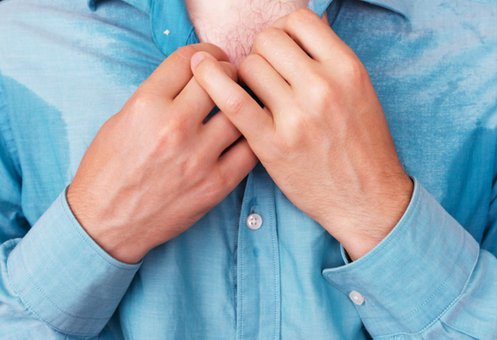What is Diaphoresis? Definition
Diaphoresis is used as a synonym of sweating in many situations. Medically, it indicates profuse sweating when there is an underlying cause such as a diseased condition or medication. [2, 3, 4, 5]
 Image 1: Diaphoresis
Image 1: Diaphoresis
Pronunciation
- dah-yah-fuh-ree-sis[1]
Meaning
- The word ‘diaphoresis’ originated from Greek and later updated with Latin.
- Diaphorein– to dissipate by perspiration [1]
What is Sweating? How is it different from Diaphoresis?
Sweating- It is one of the heat regulating mechanisms of the body, which is controlled by the sympathetic nervous system. When the body temperature is elevated, the sympathetic system gets activated by the brain.
The sympathetic nerves which innervates the sweat glands, stimulates it to produce sweat which comes out through the pores on the skin. This sweat when evaporates gives a cooling effect to the blood which flows underneath.
The cooled blood returning through the veins help in lowering the temperature of the body. Sweating occurs normally in any individual whenever the body temperature rises. This may be due to activity, stress or emotion. [6, 7, 8]
Diaphoresis- Though the term diaphoresis is used as a synonym to sweating; it is in fact excessive sweating which occurs due to underlying conditions such as diseases or drugs. During diaphoresis the sweating is more than which would have occurred under the normal conditions. Diaphoresis does not stop by itself without medical intervention. [7, 8, 9]
Hyperhidrosis
Excessive sweating can also be called as hyperhidrosis. This is again of two types, primary and secondary hyperhidrosis. Though the terms ‘Hyperhidrosis’ and ‘Diaphoresis’ are used interchangeably, only secondary hyperhidrosis is diaphoresis[10, 11].
| Primary Hyperhidrosis | Secondary Hyperhidrosis |
| Excessive sweating due to over activity of the sympathetic system without any other underlying cause. | Excessive sweating secondary to underlying causes such as diseases or drugs. |
| Focal sweating- usually limited to particular areas of the body. Eg: Palms, soles, under arms, face, forehead etc. | Generalized sweating. |
| First episodes often occurs during childhood or adolescence | Usually starts in adulthood or when underlying disease occurs. |
| Usually no excessive sweating during sleep. | Often experience excessive sweating during sleep. |
| Positive family history seen in most of the cases. | Family history usually not present. |
| Treatment is by addressing primary hyperhidrosis itself. | Treatment is by correcting the underlying cause. |
Table 1: Difference between Primary and Secondary Hyperhidrosis.
Causes of Diaphoresis
Diaphoresis can be caused by a lot of medical conditions, diseases or drugs. It is not necessary that everyone who are suffering from the conditions or diseases or everyone those who use the following drugs, will have diaphoresis.
They may or may not have diaphoresis as a symptom. The complete list of drugs and diseases that causes diaphoresis is out of the scope of this article.
Drugs
Drugs can cause diaphoresis.
- Commonly known to cause diaphoresis
- Desipramine
- Nortriptyline
- Pilocarpine
- Protriptyline
- Trace metals
- Zinc supplements etc[14, 15, 16].
- Commonly prescribed drugs
- Acyclovir
- Albuterol
- Amlodipine
- Atorvastatin
- Bacitracin
- Buproprion
- Ciprofloxacin
- Citalopram
- Digoxin
- Esomeprazole
- Fentanyl
- Glipizide
- Hydrocodone
- Indomethacin
- Levothyroxine
- Lidocaine
- Lisinopril
- Loratadine
- Moxifloxacin
- Naproxen
- Nifedipine
- Omeprazole
- Paroxetine
- Prednisolone
- Sertraline
- Verapamil
- Zolpidem etc.
Diseases or conditions
- Common Diseases or Conditions
- Menopause
- Obesity
- Pregnancy
- Alcoholism
- Acute febrile illness
- Heart failure
- Parkinson’s disease
- Diabetes mellitus
- Hyperthyroidism etc.
- Diseases/conditions mediated by Cerebral cortex
- Congenital autonomic dysfunction with universal pain loss
- Familial dysautonomia
- Pressure and postural hyperhidrosis etc[12, 13, 17].
- Diseases/conditions mediated by hypothalamus
- Carcinoid syndrome
- Cardiac shock
- Heart failure
- Hyperpituitarism
- Hypoglycemia
- Hypothalamic abscess or tumour
- Lymphoma
- Rheumatoid arthritis
- Stroke etc.
- Diseases/conditions mediated by medulla or spinal nerves
- Encephalitis
- Syringomyelia
- Tabes dorsalis etc.
Symptoms
Excessive sweating is the main symptom of diaphoresis. Due to excessive sweating there could be an increase in body odour, increased tiredness, dizziness, chest pain, cold clammy skin etc. may also be seen.
Moreover, diaphoresis itself being a symptom of many diseases or conditions, the symptoms will vary according to the cause. Hence, it is very important that a doctor should be visited for proper diagnosis and treatment[18, 19].
Diagnosis
The basic concept regarding diaphoresis is that, it is a symptom of another condition or disease. Hence, any clinician’s primary concern is not regarding the diagnosis of diaphoresis itself, but its underlying cause.
A complete history, along with family history, a detailed physical evaluation with appropriate investigation techniques will help the diagnosis[18].
Differential diagnosis
This again is the exclusion of various conditions which may be causing the symptom of diaphoresis. Keeping in mind the medications used by the individual, along with family history, physical examination and investigations can help to differentiate between all the causes that had been mentioned earlier[20].
Treatment
Antiperspirants can help reduce body odour in case of diaphoresis.

- Treatment of the underlying cause.
- Antiperspirants
- Botox injections
- Surgeries
- Topical anti-cholinergics
- Systemic medications- anti-cholinergic drugs, indomethacin, calcium channel blockers etc.
As seen above, a multitude of treatment options are available to treat diaphoresis. Generally most of them do not provide a complete and permanent solution. Treating the cause of diaphoresis can be helpful in most of the conditions.
Drugs are used only after considering the possible adverse effects. Rest of the treatments are of limited use is diaphoresis.
Reference:
- https://www.merriam-webster.com/dictionary/diaphoresis
- Dorland’s Medical Dictionary for Health Consumers. © 2007 by Saunders
- The American Heritage® Medical Dictionary Copyright © 2007, 2004 by Houghton Mifflin Company
- McGraw-Hill Concise Dictionary of Modern Medicine. © 2002 by The McGraw-Hill Companies, Inc
- Collins Dictionary of Medicine © Robert M. Youngson 2004, 2005
- https://www.ncbi.nlm.nih.gov/pmc/articles/PMC2866164/
- https://en.wikipedia.org/wiki/Perspiration
- http://wikidiff.com/sweating/diaphoresis
- http://study.com/academy/lesson/diaphoresis-definition-causes-treatment.html
- http://www.healthhype.com/excessive-sweating-perspiration-hyperhidrosis-and-diaphoresis.html
- https://www.sweathelp.org/home/types-of-hyperhidrosis.html
- Hurley HJ. Diseases of the Eccrine Sweat Glands. In: Bolognia
- JL, Jorizzo JL, Rapini RP et al (eds). Dermatology, Spain: Mosby, 2001; Chapter 41
- Lexi-Drugs Database, Physicians’ Desk Reference (PDR); Micromedex: Martindale: The Complete Drug Reference.
- https://www.sweathelp.org/pdf/Diseases_2009.pdf
- http://www.primehealthchannel.com/diaphoresis.html
- http://www.healthhype.com/excessive-sweating-perspiration-hyperhidrosis-and-diaphoresis.html
- https://emedicine.medscape.com/article/1073359-differential
- https://www.sweathelp.org/hyperhidrosis-treatments/treatment-overview.html
- https://emedicine.medscape.com/article/1073359-treatment
